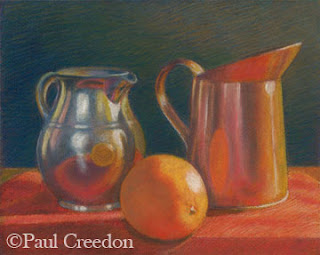 |
| Three objects, a still life by Paul Creedon. |
(Digression: I drew plenty of human figures back in the day, and the day was about 25 years long, and now I just want to do other things. Nonetheless, the teachers were right in saying that drawing the figure is the best way to learn how to draw. It's true, I think, that if you can draw a person you can draw pretty much anything else. Michelangelo believed it. End of Digression.)
Lighting in a still life
Still lifes usually have one main source of illumination. The objects don't move, and the fascination seems to lie in recognizing everyday things like fruit and bottles and tables, presented in new and different situations. Sometimes I look at something I've owned for years, and I feel as if I never saw it until I painted it.The light reflects from say, an orange, onto a silver pitcher, and the pitcher becomes something brand new. But the light and the situation have to be constant, and the pitcher and orange have to be depicted realistically, because we have to recognize the them immediately. So I work in a tight manner, and use pastel pencils with occasional forays into the land of the big pastel stick (to get a splotch of pure color) to make the onlooker's eye go where you want it to. A lot of the work is done before hand, when setting up the objects in the scene, and the trick is to represent what is laying there quietly in front of me, pretending to behave itself.
Of course there is another consideration. People like to go right up to a still life and look as closely as possible at the execution. I know I do. So the technique needs to hold up under inspection.
To be continued.
